Steak 101
The Science Behind the Perfect Steak
It’s summertime here in Texas, and BBQ season is in full swing. Today we’re not covering recipes or steps. Today we’re shifting your steak grilling skills into high-gear and teaching you the science behind the cooking. So take off your apron, put on your lab coat, and let’s learn how to grill the perfect steak!
What Cut of Steak has the Best Flavor
To grill the perfect steak, you have to start with excellent beef. That’s because choosing the right cut is like building a solid foundation for a house. If you don’t start right, it won’t matter what happens after. That’s why when picking your beef, you want to look for the most tender, well-marbled, and flavorful steaks.
When it comes to tenderness, everyone knows that the less a muscle is used, the easier it is to chew. For example, the muscles of the loin have less connective tissue than those of the leg. This is why the filet is considered a gourmet cut while the shank needs to be slow-cooked for hours.
Once you’ve chosen an excellent, tender cut, you need to look at marbling. Marbling is the fat deposits between muscle fibers. These flecks of white are a sign of high-quality meat. This is because as you cook the steak, the fat deposits melt and baste the surrounding muscle fibers. The more marbling you have, the more juicy and rich your beef will be.
But not all fat is created equal. In many of the premium cuts like ribeye, oleic acid dominates the fat structure. Studies have shown that people find fats containing high concentrations of this acid tastier than fats containing other components.
Similarly, the grass-fed, grain-finished beef we raise here at Texas Beef Company has a higher proportion of oleic and omega-3 fatty acids. That’s why our meat is known for its big beefy taste.
How to Cook Steak for the Best Flavor

After choosing the best beef for the job, the next most significant influence on the final flavor of your steak is how you cook it. Cooking meat accomplishes two things when it comes to taste.
First, the grill’s heat breaks the meat’s fatty acids into smaller molecules that quickly become airborne. Aldehydes, ketones, and alcohol molecules are responsible for the steak’s smell, contributing to the majority of its distinctively beefy flavor.
The second way that cooking builds flavor is through browning or caramelization. Chemists call this process the Maillard reaction. During this reaction, amino acids and sugars in the meat go through a series of chemical changes. The most important result of this process is the creation of pyrazines and furans. These molecules contribute to the roasted nut flavors that perfectly browned steaks have.
But be careful, the longer you cook your steak, the deeper into the Maillard reaction you go, and the more of these delicious molecules are created. But eventually, the beef will char, producing undesirable bitter, burnt flavors.
When grilling the perfect steak, the real challenge is to produce the ideal level of Maillard molecules at the exact moment that your steak reaches your desired doneness. How is this accomplished? The key is to use a two-step cooking process: First, sear your meat on a scorching grill and then bring it to your desired temperature in a 350-degree oven.
Check us out! We offer grass-fed, grain-finished, sustainably raised bulk beef and Premium Quality custom beef boxes. Each one is chock-full of all your favorite cuts. We also have tons of Texas Beef Company merchandise. Show the world that you Eat Better Beef!

